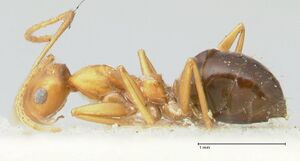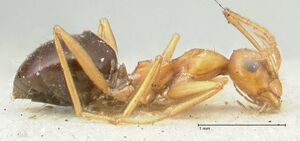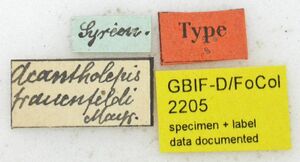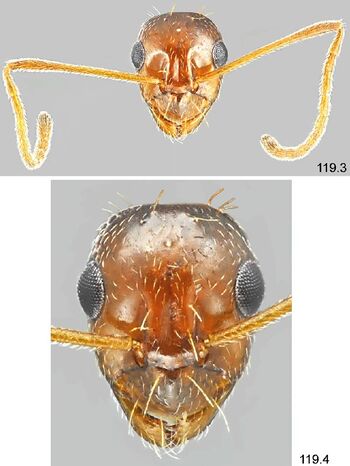Lepisiota syriaca
| Lepisiota syriaca | |
|---|---|

| |
| Scientific classification | |
| Kingdom: | Animalia |
| Phylum: | Arthropoda |
| Class: | Insecta |
| Order: | Hymenoptera |
| Family: | Formicidae |
| Subfamily: | Formicinae |
| Tribe: | Plagiolepidini |
| Genus: | Lepisiota |
| Species: | L. syriaca |
| Binomial name | |
| Lepisiota syriaca (André, 1881) | |
In Greece, where it is invasive, Lepisiota syriaca nest under stones.
| At a Glance | • Limited invasive |
Identification
Keys including this Species
Distribution
Records from Crete are probably misidentifications (Borowiec, 2014).
Latitudinal Distribution Pattern
Latitudinal Range: 36.85° to 27.033333°.
| North Temperate |
North Subtropical |
Tropical | South Subtropical |
South Temperate |
- Source: AntMaps
Distribution based on Regional Taxon Lists
Palaearctic Region: Armenia, Azerbaijan, Greece, Iraq, Israel, Syria (type locality), Türkiye.
Distribution based on AntMaps
Distribution based on AntWeb specimens
Check data from AntWeb
Countries Occupied
| Number of countries occupied by this species based on AntWiki Regional Taxon Lists. In general, fewer countries occupied indicates a narrower range, while more countries indicates a more widespread species. |

|
Estimated Abundance
| Relative abundance based on number of AntMaps records per species (this species within the purple bar). Fewer records (to the left) indicates a less abundant/encountered species while more records (to the right) indicates more abundant/encountered species. |

|
Habitat
Borowiec and Salata (2022), for Greece - Invasive species, noted only from ruderal sites, grass areas, roadsides and dry riverbeds in tourist resorts and towns. All records are from low altitude between 14 and 100 m.
Biology
Castes
Worker
     
| |
| . | |
Queen
  
| |
| . | |
Nomenclature
The following information is derived from Barry Bolton's Online Catalogue of the Ants of the World.
- syriaca. Acantholepis frauenfeldi var. syriaca André, 1881b: 61, pl. 3, fig. 8 (w.q.m.) SYRIA. Tohmé, H. & Tohmé, G. 1980c: 521 (l.). Combination in Lepisiota: Bolton, 1995b: 228. Raised to species: Tohmé, H. & Tohmé, G. 1980c: 518. See also: Viehmeyer, 1922: 215.
Unless otherwise noted the text for the remainder of this section is reported from the publication that includes the original description.
Description
Worker
Borowiec and Salata (2022) - Moderately large, HL: 0.643-0.754 (mean 0.701); HW: 0.500-0.633 (mean 0.561); SL: 0.889-1.078 (mean 0.962); EL: 0.160-0.209 (mean 0.183); ML: 1.02- 1.301; MW: 0.38-0.49. Color. Head from bicolor, mostly reddish with obscure brown occipital part to completely dark brown, mesosoma from completely red to mostly dark brown with reddish constricted part of mesonotum and adjacent parts of pronotum and mesonotum, petiolar scale from uniformly reddish to mostly dark brown with reddish base, gaster from brown to black; antennae in pale forms completely yellowish to reddish, in dark forms scapus with reddish brown basal half and brown distal half, in the darkest form whole scapus brown, funicle always yellowish to reddish; coxa in the palest form reddish, fore legs reddish, mid and hind femora and tibiae indistinctly infuscated and tarsi yellowish; in dark forms coxa, femora and tibiae dark brown to almost black with yellowish knee and apex of tibia, tarsi always yellow to reddish. Head. 1.2-1.3 times longer than wide, in front of eyes slightly convex and narrowed to mandibles, behind eyes relatively regular ly rounded, occipital margin convex. Clypeus with convex anterior and straight posterior margin, arched medially, with smooth, obtuse median keel, on the whole surface with diffused microreticulation, with sparse and long appressed hairs and a row of 4-5 long setae close to anterior margin and a pair of long, erected setae close to posterior margin, the longest anterior seta with length 0.130. Head distinct microreticulate, appears indistinctly shiny, with a pair of erected setae in interantennal and interocular area and 2-4 erected setae in occipital part of head, gena and ventral side of head also lacking erected setae. Scape long, 1.53-1.79 times longer than width of head, in basal 3-4 length thin then distinctly widened and again constricted before apex, reaching strongly beyond the occipital margin of head, surface microreticulate but shiny, with short and sparse appressed pubescence, erected setae absent. Funicular segments elongate, thin, first segment 2.9 times as long as wide and 1.5 times longer than second segment, the second funicular segment 2.1 times as long as wide, and slightly shorter than third segment, the rest of funicular segments clearly longer than broad. Eyes big, short oval, 0.26 length of head. Mandibles long, without longitudinal sculpture, shiny, with large apical dent and 4 smaller denticles on masticatory margin. Mesosoma. Elongate, in dorsal view distinctly constricted in the middle, 2.5-2.8 times as long as wide, dorsally and laterally distinctly microreticulated, surface indistinctly shiny. In lateral view pronotum convex, metanotum strongly constricted in front of spiracles, propodeum laterally tuberculate, apex of tubercle with spiniform denticle. Whole mesosomal surface covered with short and sparse appressed pubescence, pronotum with 3-10 erected setae, mesonotum with up to two and propodeum with 0-4 erected setae. Waist and gaster. Petiolar scale thick in lateral view and narrow in anterior view, widened at the middle, apex deeply emarginate, anterolateral corners form acute denticle, with 0-1 erected setae. Gaster slightly longer than mesosoma, first tergite with microreticulation, subsequent tergites microreticulate, close to apex microreticulation tends to form transverse cells, surface shiny, covered with short and sparse appressed pubescence, distance between hairs mostly larger than their length. Usually no erected setae on surface of tergites except transverse row of long, erected setae close to posterior margin but in some specimens first gastral tergite in the middle with 1-2 short to long erected setae. Legs. Fore tibia with broad, apical pectinate spur, mid and hind tibia with two simple spurs apically. Ventral surface of fore femora without or with a single erected seta basally, of mid and hind femora lacking erected setae.
References
- André, E. 1881b. [Untitled. Introduced by: "M. Ernest André, de Gray, adresse les descriptions de trois nouvelles espèces de Fourmis".]. Bull. Bimens. Soc. Entomol. Fr. 1881: 60-62 (page 61, pl. 3, fig. 8 worker, queen, male described)
- Aneed, I.K., Augul, R.S., Al-Bahadyli, L.J.M. 2018. New additional records for ant fauna from Iraq. Pakistan Entomologist 40(2): 63-70.
- Bolton, B. 1995b. A new general catalogue of the ants of the world. Cambridge, Mass.: Harvard University Press, 504 pp. (page 228, Combination in Lepisiota)
- Borowiec, L. & Salata, S. 2013. Ants of Greece – additions and corrections (Hymenoptera Formicidae). Genus (Wroclaw) 24, 335-401.
- Borowiec, L. 2014. Catalogue of ants of Europe, the Mediterranean Basin and adjacent regions (Hymenoptera: Formicidae). Genus (Wroclaw) 25(1-2): 1-340.
- Borowiec, L., Salata, S. 2022. A monographic review of ants of Greece (Hymenoptera: Formicidae). Vol. 1. Introduction and review of all subfamilies except the subfamily Myrmicinae. Part 1: text. Natural History Monographs of the Upper Silesian Museum 1: 1-297.
- Borowiec, L., Wieczorek, K., Salata, S. 2021. Review of ants (Hymenoptera: Formicidae) of the Dodecanese Archipelago, Greece. Annals of the Upper Silesian Museum in Bytom Entomology 30: 1-33 (doi:10.5281/ZENODO.5571270).
- Bračko, G. 2019. New data on the ant fauna (Hymenoptera: Formicidae) of Azerbaijan. Caucasian Entomological Bulletin 15, 165–175 (doi:10.23885/181433262019151-165175).
- Kiran, K., Karaman, C. 2020. Additions to the ant fauna of Turkey (Hymenoptera, Formicidae). Zoosystema 42(18), 285-329 (doi:10.5252/zoosystema2020v42a18).
- Salata, S., Borowiec, L., Trichas, A. 2020. Review of ants (Hymenoptera: Formicidae) of Crete, with keys to species determination and zoogeographical remarks. Monographs of the Upper Silesian Museum No 12: 5–296 (doi:10.5281/ZENODO.3738001).
- Snegovaya, N., Shigayev, C. 2021. A checklist of the ants (Insecta, Formicidae) of Azerbaijan Republic. Iranian Journal of Animal Biosystematics 17(2): 179-207 (doi:10.22067/ijab.2022.67343.1000).
- Stitz, H. 1928. Zoologische Streifzüge in Attika, Morea und besonders auf der Insel Kreta. VIII. Hymenoptera: Formicidae. Abhandlungen des Naturwissenschaftlichen Vereins zu Bremen 27: 90-91.
- Tohmé, H.; Tohmé, G. 1980c. Contribution à l'étude systématique et biologique de Acantholepis syriaca André (Hymenoptera, Formicidae, Formicinae). Bull. Mus. Natl. Hist. Nat. Sect. A Zool. Biol. Écol. Anim. (4) 2: 517-524 (page 518, Raised to species)
- Tohmé, H.; Tohmé, G. 1980c. Contribution à l'étude systématique et biologique de Acantholepis syriaca André (Hymenoptera, Formicidae, Formicinae). Bull. Mus. Natl. Hist. Nat. Sect. A Zool. Biol. Écol. Anim. (4) 2: 517-524 (page 521, larva described)
- Viehmeyer, H. 1922. Neue Ameisen. Arch. Naturgesch. (A)88(7 7: 203-220 (page 215, see also)
References based on Global Ant Biodiversity Informatics
- Borowiec L. 2014. Catalogue of ants of Europe, the Mediterranean Basin and adjacent regions (Hymenoptera: Formicidae). Genus (Wroclaw) 25(1-2): 1-340.
- Borowiec L., and S. Salata. 2012. Ants of Greece - Checklist, comments and new faunistic data (Hymenoptera: Formicidae). Genus 23(4): 461-563.
- Finzi, B.. "Risultati scientifici della spedizione di S. A. S. il Principe Alessandro della Torre e Tasso nell'Egitto e peninsola del Sinai. XI. Formiche." Bulletin de la Société Entomologique d'Egypte 20 (1936): 155-210.
- Izhaki I., B. Idelovich, R. Laster, and Y. Ofer. 2009. The impact of macro- vs micro environmental factors on the structure of ant communities inhabiting East-Mediterranean Aleppo pine forests. Israel Journal of Entomology 39: 129-146.
- Kugler J. 1988. The zoogeography of Israel. 9. The zoogeography of social insects of Israel and Sinai. Monographiae biologicae 62: 251-275.
- Salata S., and L Borowiec. 2017. Species of Tetramorium semilaeve complex from Balkans and western Turkey, with description of two new species of (Hymenoptera: Formicidae: Myrmicinae). Annales Zoologici (Warsaw) 62:279–313.
- Santschi, F.. "Fourmis d'une croisière." Bulletin et Annales de la Société Entomologique de Belgique (Bruxelles) 74 (1934): 273-282.
- Tohme G. 1996. Formicidae. Etude de la diversité biologique n° 4 . Ministère de lAgriculture à Beyrouth (Eds.). P85-87.
- Tohme G., and H. Tohme. 2014. Nouvelles liste des especes de fourmis du Liban (Hymenoptera, Formicoidea). Lebanese Science Journal 15(1): 133-141.
- Tohmé, H., and G. Tohmé. "Contribution à l'étude systématique et biologique de Acantholepis syriaca André (Hymenoptera, Formicidae, Formicinae)." Bulletin du Muséum National d'Histoire Naturelle Section A Zoologie, Biologia et Écologie Animales (4) 2 (1980): 517-524.
- Vonshak M., and A. Ionescu-Hirsch. 2009. A checklist of the ants of Israel (Hymenoptera: Formicidae). Israel Journal of Entomology 39: 33-55.



